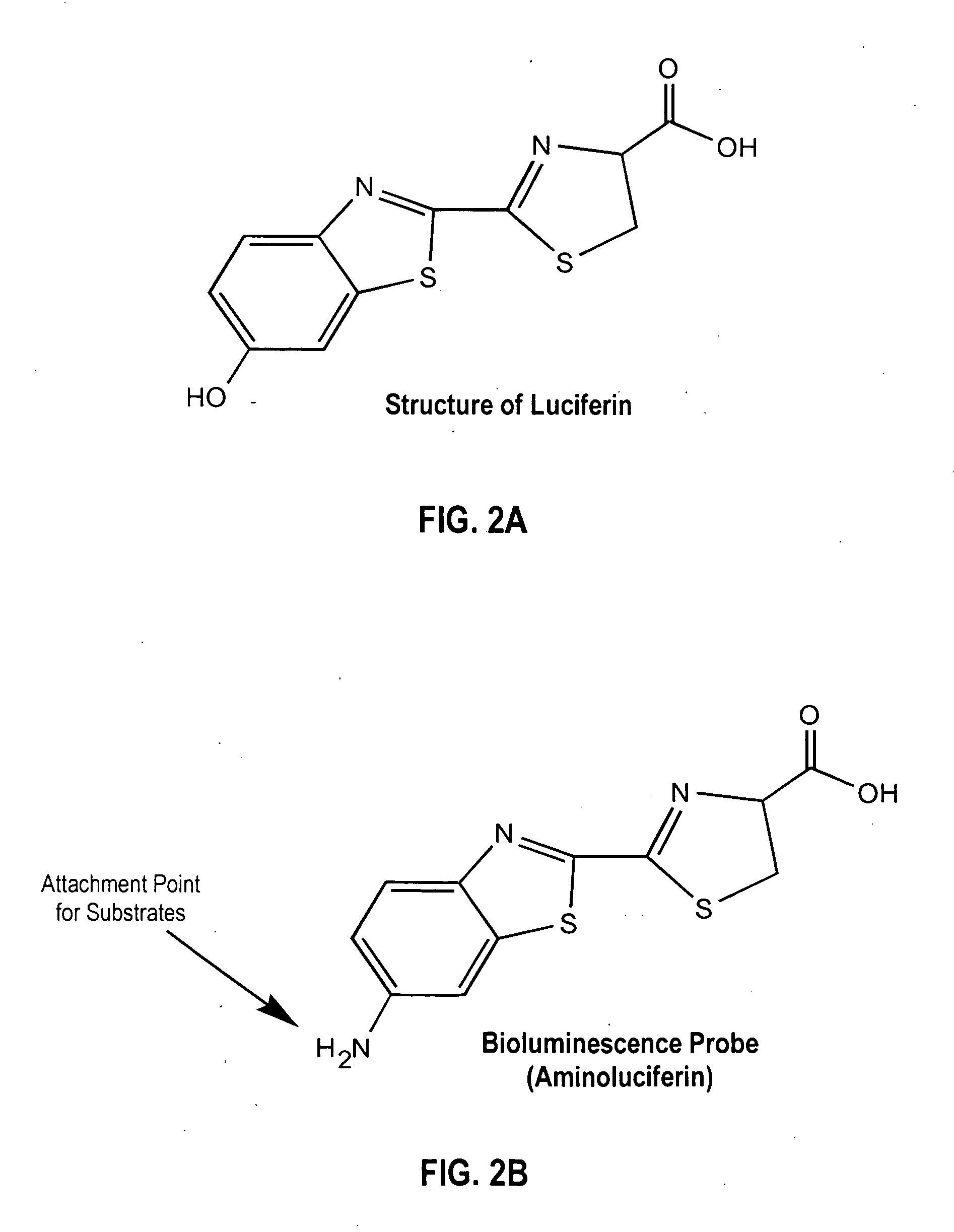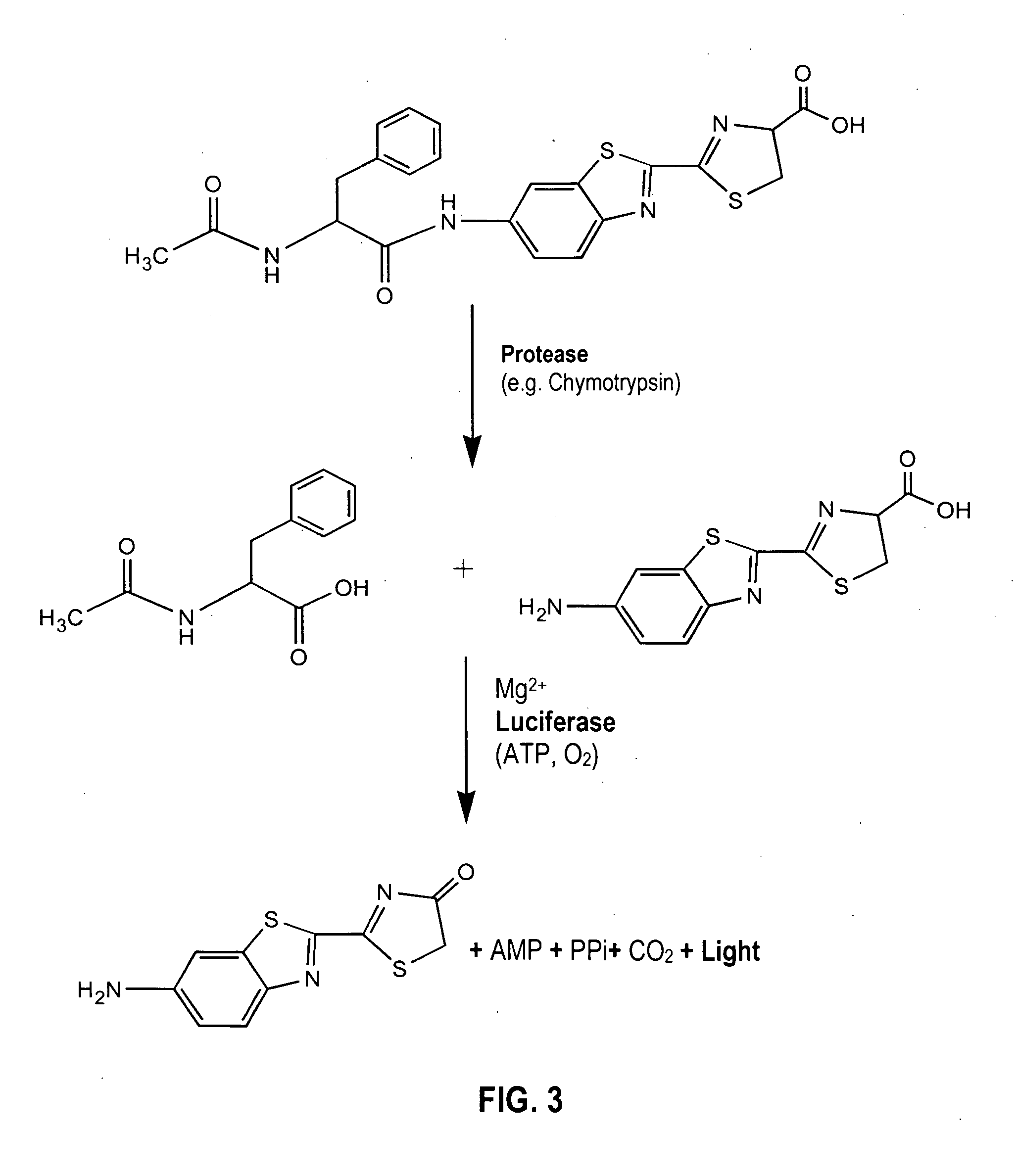Luciferyl peptide substrate
a technology of luciferin and substrate, which is applied in the field of multifunctional bioluminescent substrate preparation, can solve the problems of difficult identification of reaction and its parameters within the system, complex vivo studies, and inability to take into account the effects of in vitro reactions, and achieve the effect of facilitating localization of luciferin-agent conjugates
- Summary
- Abstract
- Description
- Claims
- Application Information
AI Technical Summary
Benefits of technology
Problems solved by technology
Method used
Image
Examples
example 1
Aminoluciferyl Substrates and Enzymes for Use in in vivo Models
[0051] The efficacy of the luciferyl peptide substrates of the present invention in in vivo models may be determined by using the five enzymes and the eight aminoluciferyl peptide substrates shown in Table 2.
TABLE 2ENZYMEAMINOLUCIFERYL SUBSTRATESCathepsin B1) Bz-Arg-aLuc2) Pyr-Phe-Leu-aLuc3) Z-Arg-Arg-aLucPSA4) Ac-His-Ser-Ser-Lys-Leu-Gln-aLuc5) Ac-Ser-Lys-Leu-Gln-aLucMMP-2 and MMP-96) Ac-Gly-Pro-Leu-Gly-Ile-Ala-Gly-Gln-aLucThrombin7) Bz-Phe-Val-Arg-aLucHIV Protease8) Abz-Thr-Ile-Nle-aLuc-Phe-Gln-Arg-NH2
[0052] The aminoluciferyl peptide substrate identified by No. 5 in Table 2 (Ac-Ser-Lys-Leu-Gln-aLuc referred to as “SKLQ-aLuc”) was synthesized as a substrate for PSA. The sequence selected for the peptide is relatively specific for PSA over other enzymes. The amount of aminoluciferin released is quantified by its instantaneous reaction with luciferase.
example 2
The Effect of PSA-Specific Aminoluciferyl Peptide Substrates on PSA Secreting Cells—an in vitro Model
[0053] To study the relationship of the PSA-specific aminoluciferyl peptide substrates on PSA secreting cells, SKLQ-aLuc was introduced in LNCaP, a prostate cancer cell line that produces PSA, and PC3M, a prostate cancer cell line that does not produce PSA. The LNCaP cells were incubated for 5 and 19 hours, which represented two time intervals during which the cells were to synthesize PSA, and both cell lines were transfected with SKLQ-aLuc to produce luciferase. Dihydroxytestosterone (“DHT”) was used to investigate its influence on cell growth and PSA production. The cell culture media was serum-free to prevent PSA from forming complexes with various serine-protease inhibitors that are present in the serum. The results of this experiment are shown in FIG. 7, which demonstrate that the amount of aminoluciferyl peptide detected in the cells is directly proportional to the amount of P...
example 3
The Effect of PSA-Specific Aminoluciferyl Peptide Substrates on PSA Secreting Cells—an in vivo Model
[0054] The peptides were then tested in severe compromised immune deficiency (SCID) mice that bore an LNCaP tumor implanted at a subcutaneous site. FIG. 8A shows the presence of 2 week old LNCaP tumors on the right flank of the mice. The mice were injected with luciferin to localize the tumors and confirm their presence. FIG. 8B shows light emission from these tumors 2 months after injecting the PSA-specific aminoluciferyl peptide SKLQ-aLuc. The aminoluciferin released from the cleavage of the peptide by PSA is transported across the LNCaP cell membrane and reacts with luciferase to emit light. Thus, the aminoluciferyl peptide is activated by PSA and consequently can be used to target PSA producing cells in animal models.
PUM
| Property | Measurement | Unit |
|---|---|---|
| emission wavelength | aaaaa | aaaaa |
| structure | aaaaa | aaaaa |
| Biological imaging | aaaaa | aaaaa |
Abstract
Description
Claims
Application Information
 Login to View More
Login to View More - R&D
- Intellectual Property
- Life Sciences
- Materials
- Tech Scout
- Unparalleled Data Quality
- Higher Quality Content
- 60% Fewer Hallucinations
Browse by: Latest US Patents, China's latest patents, Technical Efficacy Thesaurus, Application Domain, Technology Topic, Popular Technical Reports.
© 2025 PatSnap. All rights reserved.Legal|Privacy policy|Modern Slavery Act Transparency Statement|Sitemap|About US| Contact US: help@patsnap.com



